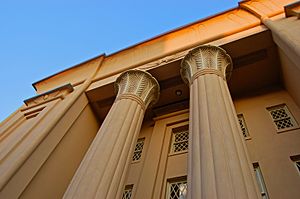Egyptian Building facts for kids
|
Egyptian Building
|
|

Front view of the Egyptian Building
|
|
| Location | Richmond, Virginia |
|---|---|
| Built | 1845 |
| Architect | Thomas Stewart |
| Architectural style | Egyptian Revival |
| NRHP reference No. | 69000321 |
Quick facts for kids Significant dates |
|
| Added to NRHP | April 16, 1969 |
| Designated NHL | November 11, 1971 |
The Egyptian Building is a really old and cool college building in Richmond, Virginia. It was finished way back in 1845! This building was the first permanent home for the medical school that eventually became part of Virginia Commonwealth University (VCU).
Experts say it's one of the best examples of Egyptian Revival architecture in the whole country. This style looks like ancient Egyptian temples. The Egyptian Building is so important that it's listed on several historic registers. It became a National Historic Landmark on November 11, 1971.
Contents
History of the Egyptian Building
After using the Union Hotel for a few years, the college needed its own special place. They wanted a building just for teaching medicine. The state of Virginia helped by offering a $25,000 loan. The city of Richmond also donated $2,000.
The college board chose a famous architect named Thomas Somerville Stewart. He had just finished building a church in Richmond. Stewart decided to design the new college building in the Egyptian Revival style. This was seen as a very unique and "exotic" choice.
Why an Egyptian Style?
The board thought the Egyptian style was a great idea. They believed that medicine first started in ancient Egypt. A famous doctor named Imhotep was an early Egyptian physician. Sir William Osler, a well-known medical figure, said Imhotep was the "first figure of a physician to stand out clearly."
The Egyptian Building was first called the College Building. Later, it was known as the Old College Building. Many people think it's the oldest medical college building in the South. Its walls are wider at the bottom, like the temples of ancient Egypt.
What Was Inside?
The building was used for most school activities until the 1890s. It had lecture halls where students learned about medicine. There was also a room for dissecting bodies to study anatomy. Plus, it had hospital beds for patients needing medical care.
In 1939, the building was fixed up by architects Baskervill and Son. This was done to honor Dr. Simon Baruch, who graduated in 1862. During this time, the inside of the building was also changed to match the Egyptian style.
A Lasting Landmark
The Egyptian Building has been used continuously since it was built in 1845. In 1969, it officially became a historic landmark. In 1995, it celebrated its 150th birthday! Every school in the Medical College has used it at some point.
The VCU Medical Center campus really loves the Egyptian Building. In 1940, a historian named Dr. Wyndham Blanton spoke about its importance. He said it was like a "shrine" or a "sanctuary of tradition." He compared it to famous buildings at other universities. He felt it was a "spiritual heritage" for the college.
Architecture of the Egyptian Building
The building is made from brick, stucco, and cast iron. Its walls are built to look very strong and tall. They are slightly thinner at the top than at the bottom. This makes the building seem even more solid.
Unique Features
The building has few windows for its size, which adds to its solid look. These windows have diamond-shaped panes. A key part of the building is its large porches at each end. These porches have huge columns with detailed palm frond tops. The columns themselves look like bundles of reeds.
Several tall, thin stone pillars called obelisks stand next to the building. They are connected by a cast-iron fence. This fence has decorations that look like sarcophagi, which are ancient Egyptian mummy cases. R. W. Barnes of Richmond made these iron pieces.
You'll also see the Winged sun disk design all over the building. On the outside, it's repeated on the decorative tops of the main wall sections. This winged disk shows Horus, an Egyptian god, as a sun disk with wings. Two snake goddesses are on either side. This was the form Horus took when he fought the god Set in Egyptian stories.
Inside the Building
Inside, you'll find the lotus flower design used many times. The colors inside also have special meanings. Red stands for divine love, blue for divine intelligence, and golden yellow for God's mercy.
You can see hieroglyphs (ancient Egyptian writing) in the decorations of the entrance room. The floor tiles even show a large scarab beetle.
The horizontal stone piece above a doorway is called a lintel. On one lintel, it says, "Tutankhamen: To whom life is given forever." On the other side, it reads, "Tutankhamen: Living image of Amon." This message probably shows how excited people were about the child Pharaoh, King Tut. His tomb was discovered in 1922, around the time the building's interior was remodeled.




